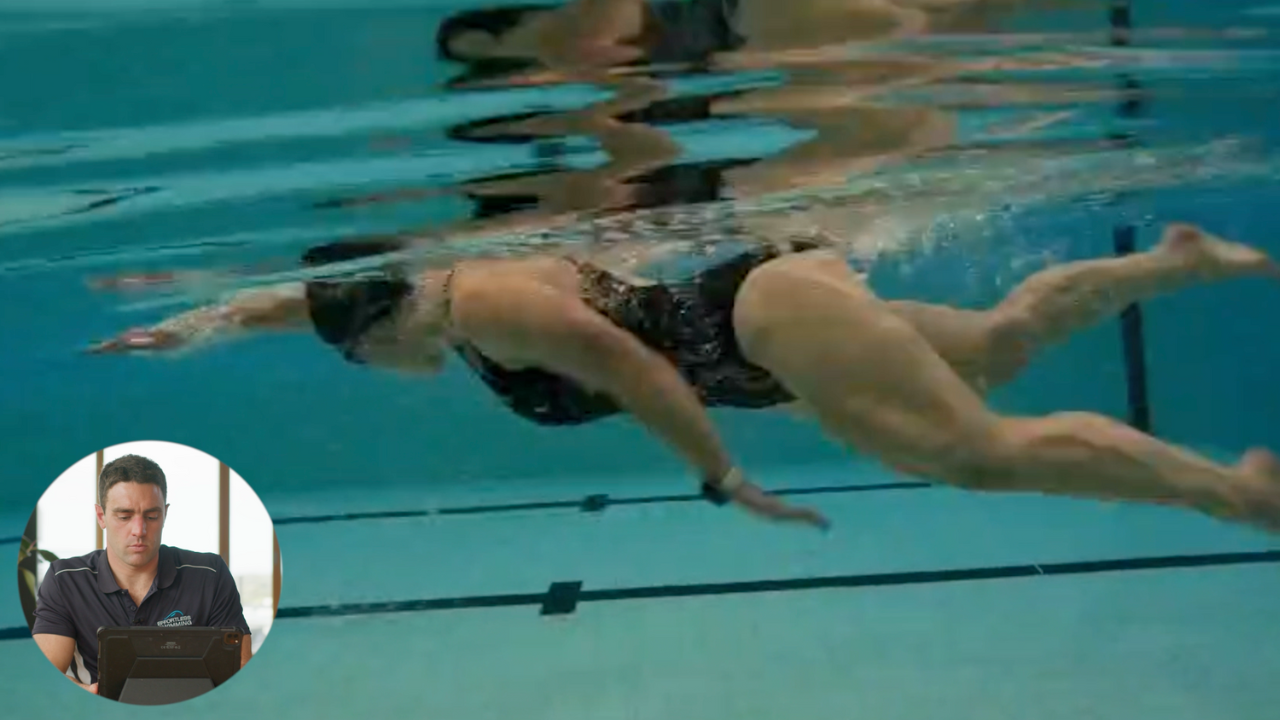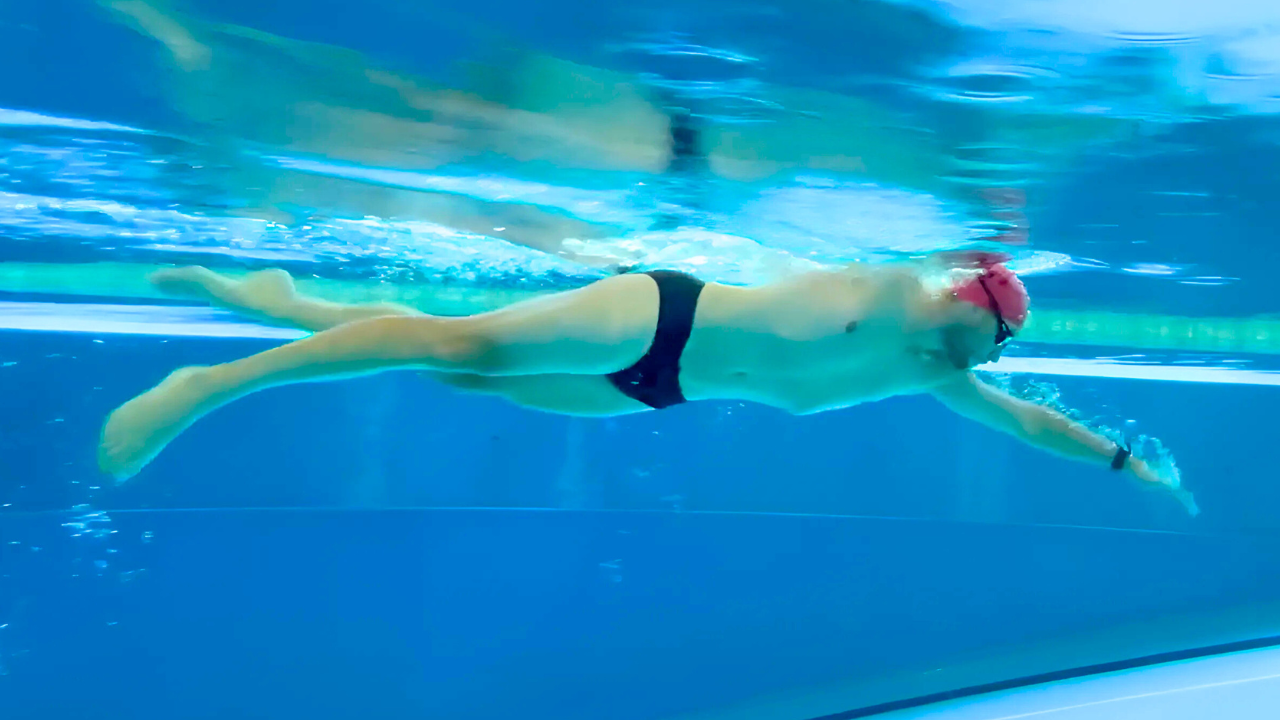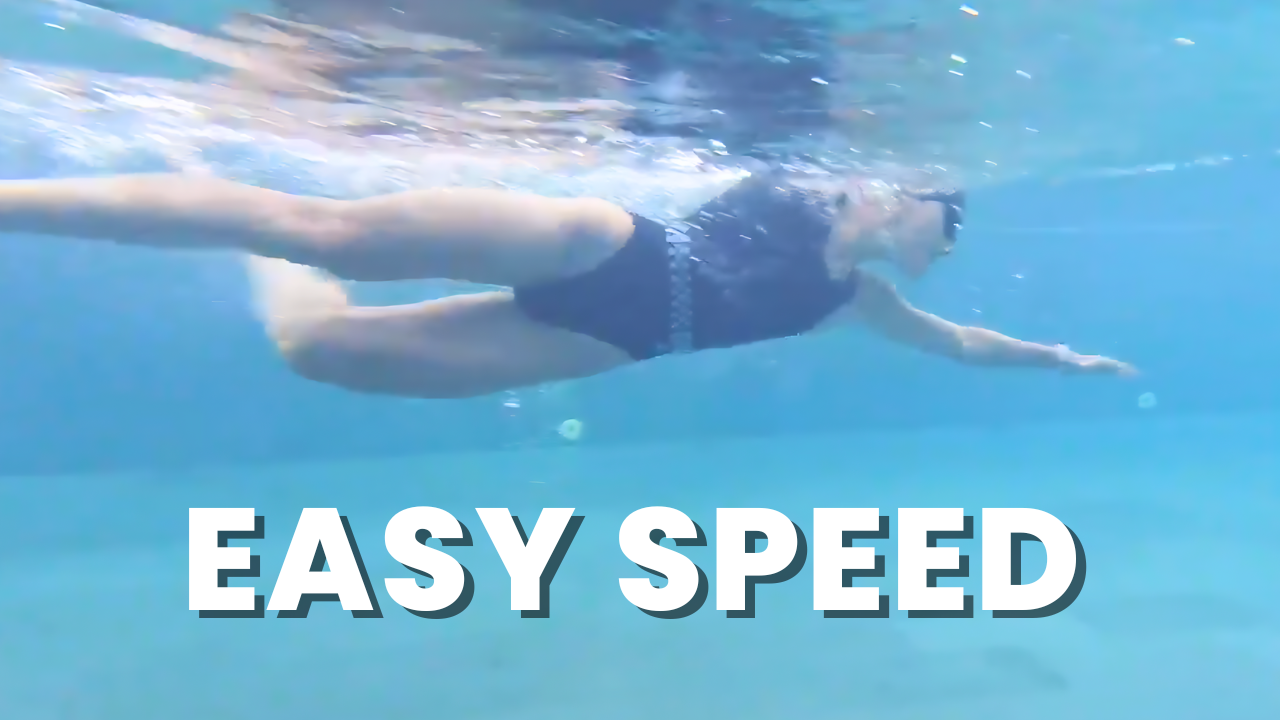Transcription:
All right. We’re currently on lockdown, so I’ve got a little helper with me and what are we going to watch today Sammy?
Swimming.
Some swimming videos. So we’re going to look at some movies, some TV shows that may not show swimming in the best possible way where we’ll have a look at the technique of some of the actors and also some funny scenes from a couple of different movies. So if you look at this first one here, this is probably my favorite. This is a movie called Pride from 2007 and this is the final scene. Now you’ll really enjoy this breakout. So we’ve got the dive here and this next part has looked at this beautiful butterfly split, sorry breaststroke, split pull into a freestyle stroke. So, I don’t know how many freestylers are doing that. It might be a new type of technique, but we’ll come back to that movie at the end of this video as well. There’s another sort of good sane from that.
This is the Valhalla Murders, which is a Netflix show. And you’ll see here with this swimmer, all right, this one with paddles on and what’s pretty common, something that we see all the time is that when someone’s fairly new to swimming, they often will overreach on their entry and so, you’ll notice that the elbow lands first and then the hand is the last thing there. So as you go through this part here, as you slowly go through it, that elbow lands first.
So sometimes when we see people doing that, we want them to get their fingers first elbow up. So there’s this triangle shape on entry. That way you can just extend forward, slide the hand forwards under the surface of the water. And what normally happens if you overreach above the water, sometimes the legs will drop because then you’ve got maybe two, three kilos being held up above the water for a split second, which can just cause the legs to drop a little bit. So what I’d encourage this actor to do is get the fingertips in first and then slide the hand forwards. You’ll also see out the back on the left-hand side, that it’s really short exit so it’s coming out well before the hip and we want to exit just past the hip there.
All right. And then you’ll also see it like the head position is pretty high, normally you want about three or four centimeters of the head above the water and the head down a little bit deeper. So that will also help bring her legs up and just make her a lot smoother, more efficient through the water. And I mean the breathing, yes, you could get the breath a little bit lower, but I think the overall head position is just that a little bit too high.
Okay. This next one, this is… What have we got here? Oh, this is a TV show from Netflix called Elite and now we get a little bit of a view here and this swimmer, you’ll see he’s got a little bit of a crossover on this entry point. The fingers are starting to come up a bit now at the back of this stroke. You’ll see as he comes in that that hand is sort of coming like back past his hip there and it’s causing him to be a little bit unbalanced.
And you’ll notice the kick is fairly wide and as he moves through this part of the stroke, that’s not too bad, but he’s a bit deep and a little bit too centered. So in this phase of the stroke, the hand should ideally be a bit wider than the shoulder and we want this half diamond shape. If you’ve seen our videos talking about the power diamond, then we want that diamond shape on exit. But he’s just a little bit too far under and a little bit too deep. And if you have a look at this last section, you’ll notice that the hand is kicking out wide from here to here, whereas it should just press back past the hip. And again you get a little bit of that unbalanced position where he’s over-rotating through the shoulders way too much. He is at about 70 degrees, keep it to about 45 degrees and that’s going to help them a lot with this lead hand catch.
Then, this next one, this is a TV show, an Australian TV show and you’ll see here, well there are a few things that will probably stand out to you on this one. You’ll notice that the head position to start with, the eyes are nearly out of the water, which might typically when someone’s, well, not a natural swimmer or there they have some sort of fear around it. They’ll often have their head up really high and sometimes look too far forwards and it makes it harder for them to actually swim well.
So what you’ll probably want to start with is just look a bit further down, even at 45 degrees to help just improve the body position and after that as well. What she could do is just change that entry as well. You say it’s a really, really elbow first entry and she’s just almost patting the water on top. You can probably see it here too. Her legs are kicking pretty hard just to keep the back half up. But if she can just get ahead down, get her fingertips to enter first, then it’s going to really change the balance of the body there. And this is kind of like a lifeguard at an annoyed lifeguard that you might get at the pool sometimes.
Now this next one, all right, this is from a TV show called Sex Education on Netflix. And you’ll see here, I really like this scene, I’ll play it through first they’ve got some proper swimmers here that he’s racing against and have a look at the stroke rate of this guy in the green cap. He’s got to go so slow to let this guy beat him. And you know, I don’t like to sort of payout people for their technique because you know cause everyone starts from zero. But it is kind of good to look at this in, in some movies. So you see here the first thing from underwater, that is a pretty crazy kick and there’s a lot of knee bend going on and you’ll notice that his knees, his legs are coming well below his body. And the first way that you’ll swim faster is to minimize drag. And there’s a lot of drag. That’s-
You all right bud?
That’s going on. So, we’d want to smooth out that kick. Keep the kick fairly straight, make it feel really small. And you also see that he’s kind of… Well, he’s just over rotating through his shoulders above the water, which you can kind of see there and there’s a big throw of the head off to the side. So, bye, first of all, fixing the kick and then kind of length thing at the entry, you’ll see it into super close to his head. That hand’s turned way off to the side as well. It’s just a very inefficient stroke and you can say how early this catch begins. So is there, and right now there’s nothing in front of his head. So he’s not really front quadrant. And in this part of the stroke have a look at his shoulder. It is… well he’s way on the side at the same time, his hand is passing underneath. So it just means like the timing of the stroke is way off.
That’s a big out sweep that he’s got going on there as well. So what he could do there is, you know what we want to aim for is don’t let that hand go wider than the elbow. Keep it on the inside there and then you’ll get so much more out of it. Because if you start too wide, if you drift out too wide, that palm of the hand is going to face the body. Very little propulsion that he’s getting from it there and same out the back, you can see once he’s there, there is nothing else that he’s getting out of the back of the stroke so he could basically be going the same speed for about half the effort with a couple of changes.
All right, let’s see what else we’ve got and this is the dive. So the same TV show off the dive. What you want to do here is get their eyes down. The eyes should be looking downwards as you’re about to start off the block and you want your hips to be up a little bit higher there as well and head down.
Let’s see what else we’ve got. So this is… Well, this is… if this is Daniel Craig, this is him swimming in Skyfall, the movie, it’s not bad. You can see got nice recovery out of the top of the water enters pretty well there. It’s nice, he reaches forwards pretty well. So if that is him swimming, he’s doing a pretty reasonable job there. He’s probably… Look, you can see his kick, he’s kicking fairly hard here so you could probably back off the cake a little bit. Yes, keeping his back half up. But a lot of times when we’ve got people coming to clinics and they’re working their legs that hard, what we encourage them to do is make the kick feel super easy, like a two or three out of 10 and that just with that more relaxed kicking, you can keep your heart right down and you can swim a lot further for the same amount of effort. But it can feel like… It’s kind of like a panic kick where it’s like you don’t want your legs to sink. But overall it’s pretty good.
Now this is Tom Hanks swimming. It’s supposed to be Tom Hanks swimming doesn’t look like him from above, but maybe it is, we’ll see. You can see here, swing reasonably well, like if you can replay it through. That’s not too bad at all. From above, he’s a little bit short with his reach, so as he comes over, like he enters very close to the head there, very close to the head, and then as he extends forwards he does get a bit of reach. But he’s starting that catch a bit early. He’s not front quadrant where that front, there’s nothing in front of his head for a point in time. The same there. So, what he could do is make it feel super wide. So get rid of this crossover here, make that feel really wide, make it feel like he’s got a lot more sort of glide in the stroke. Like he’s spending a little bit more time reaching and extending out in front.
And, you’ll probably get another 10 to 10 to 15% distance out of a stroke that he’s taking there. But it’s not too bad. It looks fairly comfortable in the water, which is good but can probably just like thin the stroke a bit. And a good way to sort of experiment with that is when we’re working with people, one of the ways we get them to identify is my stroke actually getting any better is if their stroke count comes down. So obviously there’s the right at which you take your stroke, so your cadence and the distance per stroke. And so if you are minimizing drag, if you are increasing propulsion, then if you swim at the same pace as your marker, as your test, then you’ll know that your stroke is improving. So it’s a good way to kind of have a sense of it.
So I’ll often get people to do something like six fifties or eight fifties the same pace, same time cycle or sorry, the same effort and just see if they can reduce their stroke count without obviously gliding to a ridiculous point.
Okay, this is… All right, here we go, this is that final scene again from Pride. Now I think this is the main character here. I hadn’t seen the movie but I’ve just sort of seen a couple of scenes here. So with this swimmer, he’s up against some really good legitimate swimmers here and you’ll just have a look at his stroke. There’s a big crossover going on when we get to it. So I’ll just skip this part of it. And so I think he’s the anchor leg in this relay. So if we slow it down, you’ll see massive crossover going on there and the same on that side. So again it’s that that early entry, with the fingers, then rising up, putting the brakes on and then he comes under again.
So what he could do there is look, fix that entry, get it far enough out in front of the head where just the last little bit of reach is happening under the water and reduce the shoulder rotation and probably tidy up that kick a bit because there’s a lot of drag that’s happening there. So some of these sort of common things that you’ll see you’ll see happening like, a lot of times if the kick is really ineffective, that can sometimes be the best place to start a just make that kick small light and contain it within the right sort of size there, get the entry position right.
So just make sure that it’s well-aligned that you’re swimming on those train tracks and it’s far enough out in front. The head position is obviously one that we want to get right as well. But also I just like the rotation is really common for people to over-rotate or under rotate. So just getting it to around that 35 to 45-degree range.
Thanks for watching. Make sure you like and subscribe.










